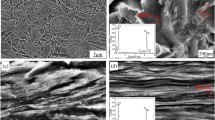Structural and phase transformations under cooling of low-carbon martensitic steels of the Cr – Mn – Ni – Mo – V – Nb system with carbon content 0.15 and 0.27% are studied. The microstructure is investigated by optical and electron microscopy, measurement of hardness, x-ray diffraction analysis, dilatometric and energy dispersive analyses. The strength and ductility parameters are determined in tensile tests. The impact toughness is determined.





Similar content being viewed by others
References
H. M. Fonshtein, “Fundamental features of phase transformations of low-alloy steels under heat treatment from intercritical temperature range,” in: V. N. Urtsev (ed.), Phase and Structural Transformations in Steels [in Russian], Magnitogorsk (2008), Issue 5, pp. 62 – 75.
B. M. Bronfin, S. N. Goldshtein, and E. I. Golub, “Model of strain hardening and plasticity of ferrite-pearlite steels,” Fiz. Met. Metalloved., 60(5), 1010 – 1017 (1985).
L. I. Kogan, E. F. Matrokhina, and R. I. Entin, “Effect of austenitization in ITR on the structure and properties of low-carbon steels,” Fiz. Met. Metalloved., 52(6), 1232 – 1241 (1981).
S. K. Berezin, A. A. Shatsov, and S. K. Greben’kov, “Structure and mechanical properties of low-carbon martensitic steel quenched from intercritical temperature range,” Nauch. Obozr., No. 22, 136 – 142 (2015).
A. P. Kamenskikh, L. Ts. Zayats, L. M. Kleiner, and Yu. N. Simonov, “Special features of formation of structure and properties in low-carbon martensitic steel 12Kh2G2NMFT,” Metalloved. Term. Obrab. Met., No. 3, 10 – 12 (2003).
L. M. Kleiner and A. A. Shatsov, Structural High-Strength Low-Carbon Steels of Martensitic Class [in Russian], Izd. PGTU, Perm (2008), 303 p.
L. E. Popova and A. A. Popov, Diagrams of Transformation of Austenite in Steels and Beta Solution in Titanium Alloys: A Handbook of Heat Treatment Specialist [in Russian], Metallurgiya, Moscow (1991), 503 p.
N. A. Anufriev, A. V. Maisuradze, and Yu. V. Yudin, “Numerical simulation of structural transformations in hypoeutectoid low-alloy steels,” Metalloved. Term. Obrab. Met., No. 4, 40 – 45 (2011).
M. A. Krishtal, Diffusion Mechanism in Iron Alloys [in Russian], Metallurgiya, Moscow (1972), 400 p.
L. M. Kleiner, D. M. Shatsov, A. A. Larinin, and M. G. Zakirova, “Structure of low-carbon martensite and structural strength of steels,” Perspekt. Mater., No. 1, 59 – 71 (2011).
Yu. S. Karabasov (ed.), Steel at the Frontier of Centuries [in Russian], MISiS, Moscow (2001), 664 p.
L. Ts. Zayats, D. Yu. Panov, and Yu. N. Simonov, “Refinement of the structure of steels under intense thermal impact. Part 1. Choice of optimum alloying system,” Metalloved. Term. Obrab. Met., No. 11, 13 – 19 (2010).
V. A. Kozvonin, A. A. Shatsov, I. V. Ryaposov, et al., “Structure, phase transformations, mechanical properties and cold resistance of low-carbon martensitic steels,” Fiz. Met. Metalloved., 117(8), 862 – 870 (2016).
M. E. Blanter, The Theory of Heat Treatment. A Study Aid [in Russian], Metallurgiya, Moscow (1984), 328 p.
N. P. Antsiferov, V. A. Galushin, and M. V. Maisuradze, “Determination of critical points of structural steels under heating-cooling by the method of thermal analysis,” in: X Int. Ural Workshop of Young Metallurgists, Ekaterinburg, 7 – 11 December 2009 [in Russian], Ekaterinburg (2009), pp. 11 – 13.
Hidenori Terasaki and Yu-Ichi Komizo, “Correlation between the microstructural development of bainitic ferrite and the characteristics of martensite-austenite constituent,” Metall. Mater. Trans. A, 44(12), 5289 – 5293 (2013).
M. G. Zakirova, L. M. Kleiner, S. K. Greben’kov, and A. V. P’yankov, “Raising the stability of supercooled austenite of low-carbon martensitic steels,” Metall. Mashinostr., No. 5, 41 – 42 (2011).
S. S. Yugay, L. M. Kleiner, A. A. Shatsov, and N. N. Mitrokhovich, “Formation of structure and properties of low-carbon martensitic steel 12Kh2G2NMFT under quenching,” Fiz. Met. Metalloved., 97(1), 107 – 112 (2004).
L. M. Kleiner, D. M. Larinin, L. V. Spivak, and A. A. Shatsov, “Phase and structural transformations in low-carbon martensitic steels,” Fiz. Met. Metalloved., 108(2), 161 – 168 (2009).
The authors gratefully acknowledge the participation of Professor L. M. Kleiner in initiation of the works and the help of Professor L. V. Spivak with the calorimetric studies.
Author information
Authors and Affiliations
Corresponding author
Additional information
Translated from Metallovedenie i Termicheskaya Obrabotka Metallov, No. 2, pp. 32 – 38, February, 2019.
Rights and permissions
About this article
Cite this article
Berezin, S.K., Shatsov, A.A., Panov, D.O. et al. Formation of Grain and Packet-Lath Structure in Low-Carbon Steels After Quenching from Intercritical Temperature Range. Met Sci Heat Treat 61, 101–107 (2019). https://doi.org/10.1007/s11041-019-00383-5
Published:
Issue Date:
DOI: https://doi.org/10.1007/s11041-019-00383-5




